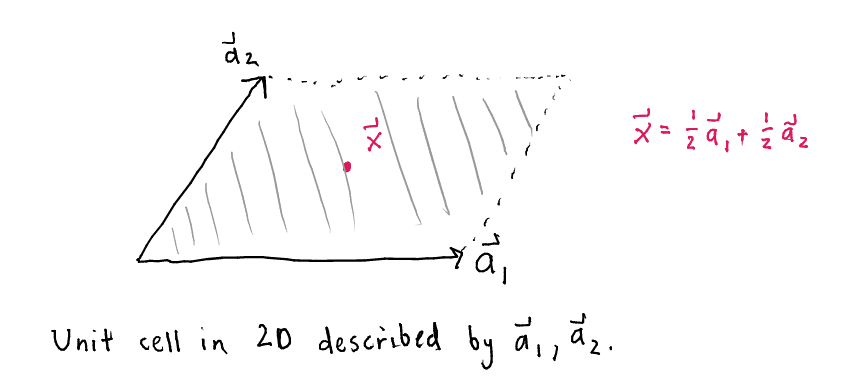The unit cell of many crystals, for example a metal-organic framework, can be described by three basis vectors , , and that form a three-dimensional parallelpiped. One can conveniently express any point inside the unit cell of the crystal as a linear combination of these vectors:
,
where are fractional coordinates. For example, in two dimensions, the shaded gray area formed by the parallelogram of the two vectors and in Fig. 1 could describe a unit cell of a crystal.

The point in Fig. 1 can be described as .
To mimick an infinite crystal during molecular simulations, we can consider only the home unit cell and impose periodic boundary conditions. For example, the electrostatic potential inside the pores of a metal-organic framework is a periodic function since we model the crystal as infinitely repeating. Using the basis vectors , , and , we can express the periodicity of as:
where , that is are integers. Fig. 2 shows a point in the home unit cell formed by and and its periodic images for our two-dimensional example (here we show and ).

The points for that form the corners of the unit cells are called a Bravais lattice.
As the electrostatic potential has the same periodicity as the Bravais lattice describing the unit cell, we can expand it in a discrete Fourier series:
essentially viewing as a function of fractional coordinates , which each have a periodicity of 1.0. The Fourier coefficients are denoted as .
We can instead express the above Fourier series as a sum over vectors :
where vectors are in the set:
The vectors are reciprocal lattice vectors, defined as:
This way,
as in the first time we wrote the Fourier series expansion of .
We can obtain the reciprocal lattice vectors from a given Bravais lattice by solving the matrix equation .
In conclusion, functions that have the same periodicity as the Bravais lattice can be expressed as a Fourier series over the reciprocal lattice vectors.
comments powered by Disqus